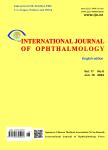Induction of significant intraocular pressure diurnal fluctuation in rats using a modified technique of microbead occlusion
Induction of significant intraocular pressure diurnal fluctuation in rats using a modified technique of microbead occlusion作者机构:Affiliated Eye Hospital School of Ophthalmology and Optometry Wenzhou Medical University Department of Ophthalmology Li Ka Shing Faculty of Medicine University of Hong Kong
出 版 物:《International Journal of Ophthalmology(English edition)》 (国际眼科杂志(英文版))
年 卷 期:2018年第11卷第7期
页 面:1114-1119页
核心收录:
学科分类:1002[医学-临床医学] 100212[医学-眼科学] 10[医学]
主 题:microbead occlusion diurnal intraocular pressure fluctuation glaucoma rat
摘 要:AIM: To investigate the effect of microbead iridocorneal angle occlusion on intraocular pressure(IOP) diurnal fluctuation in rat eyes. METHODS: Male Dark Agouti(DA) rats, 8-10 week old, were each given a single intracameral injection of microbeads, followed by injection of dispersive viscoelastic solution. The right eye served as the experimental eye, while the left eye served as the control. IOP was measured twice daily postoperatively for 3 wk and compared between groups. At the end of 3 wk, the rats were sacrificed and the eyes were harvested for histological analysis and retinal ganglion cell(RGC) counting. RESULTS: After microbead injection, experimental eyes had significantly higher dark time IOP than controls from the second week to the third week [2 nd week: 22.92±1.631 mm Hg(n=5) vs 17.35±0.751 mm Hg(n=5); 3 rd week: 23.59±1.494 mm Hg vs 17.73±0.592 mm Hg(n=5)], while light time IOP was comparable between groups. The fluctuation levels of IOP in the experimental eyes were 7.21±0.398 mm Hg(n=5), 9.50±1.017 mm Hg(n=5) and 10.66±0.894 mm Hg(n=5) from the first week to the third week after injection. Comparatively, they were significantly lower in the control eyes, which were 4.69±0.323 mm Hg(n=5), 2.84±1.122 mm Hg(n=5) and 4.98±0.603 mm Hg(n=5) respectively. However, at the end of 3 wk, the larger fluctuations in IOP in the experimental eyes was not associated with a significant loss of RGCs. CONCLUSION: Microbead occlusion exacerbates diurnal IOP fluctuation in rats. This reported model may serve as a method of investigating the pathological effects of IOP fluctuation. A longer observation period, or repeated injections, may be needed to observe a significant change in RGC density.



